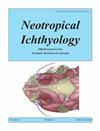新热带水库严重干旱后网箱养鱼相关鱼系的结构和组成,并与对照区进行比较
IF 2
4区 生物学
Q1 ZOOLOGY
引用次数: 2
摘要
2014年,巴西东南部的一场非典型干旱严重降低了几个水库的水位。我们调查了干旱和随后的汛期对水产养殖区和对照区鱼系动物属性的影响。2014年至2015年(干旱)和2016年(潮湿)期间,在巴西上帕拉纳本文章由计算机程序翻译,如有差异,请以英文原文为准。
Structure and composition of ichthyofauna associated with cage fish farming and compared to a control area after severe drought in a Neotropical reservoir
Abstract In 2014, an atypical drought in Southeast Brazil drastically reduced the water level in several reservoirs. We investigated the effects of this drought and the subsequent flood period on the attributes of ichthyofauna in an aquaculture and in a control area. Fish were collected bimonthly between 2014 and 2015 (drought) and 2016 (wet), using gill nets in the two sample areas in the Ilha Solteira reservoir, Upper Paraná River basin, Brazil. We compared ichthyofauna attributes between the drought and wet seasons in each area and between areas within each season. In the aquaculture area, the assemblages showed similar characteristics between the seasons. By contrast, the control area varied between seasons, with greater species richness, Shannon diversity, species evenness, and less β diversity in the wet season. Comparisons between areas in each season showed higher abundance in the fish farm within the drought season. Changes in structure and composition in the control area are possibly associated with new areas and resources made available by the flooding of marginal areas during the wet season. We inferred that the effect of the flood on the aquaculture community was attenuated by the continuous habitat structure such as shelters and food provided by the enterprise.
求助全文
通过发布文献求助,成功后即可免费获取论文全文。
去求助
来源期刊

Neotropical Ichthyology
生物-动物学
CiteScore
2.80
自引率
17.60%
发文量
24
审稿时长
6-12 weeks
期刊介绍:
Neotropical Ichthyology is the official journal of the Sociedade Brasileira de Ictiologia (SBI). It is an international peer-reviewed Open Access periodical that publishes original articles and reviews exclusively on Neotropical freshwater and marine fishes and constitutes an International Forum to disclose and discuss results of original research on the diversity of marine, estuarine and freshwater Neotropical fishes.
-Frequency: Four issues per year published only online since 2020, using the ‘rolling pass’ system, which posts articles online immediately as soon as they are ready for publication. A searchable and citable Digital Object Identifier (DOI) is assigned to each article immediately after online publication, with no need to await the issue’s closing.
-Areas of interest: Biology, Biochemistry and Physiology, Ecology, Ethology, Genetics and Molecular Biology, Systematics.
-Peer review process: The Editor-in-Chief screens each manuscript submitted to Neotropical Ichthyology to verify whether it is within the journal’s scope and policy, presents original research and follows the journal’s guidelines. After passing through the initial screening, articles are assigned to a Section Editor, who then assigns an Associate Editor to start the single blind review process.
 求助内容:
求助内容: 应助结果提醒方式:
应助结果提醒方式:


